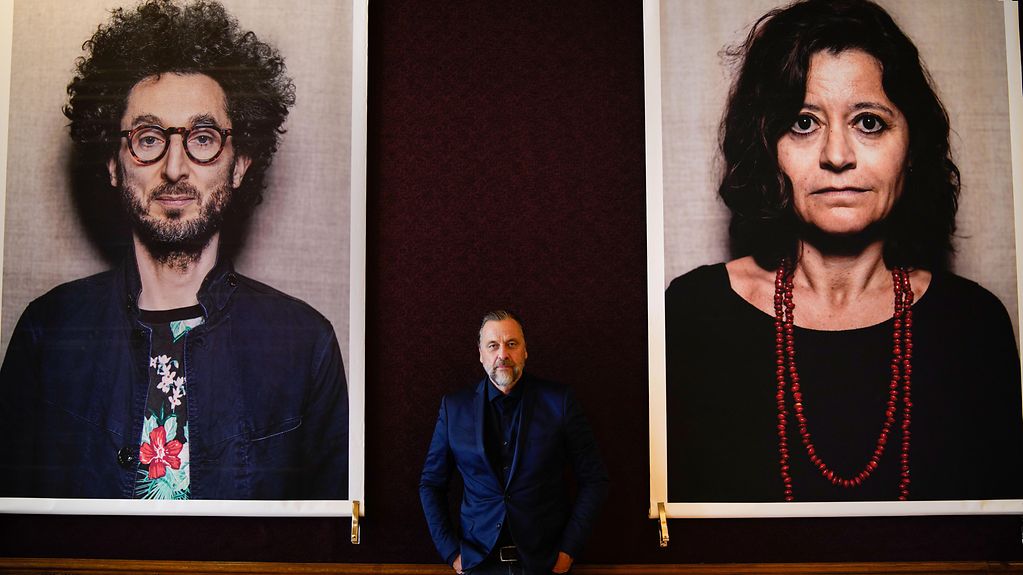Faces of Europe - Interview with photographer Carsten Sander
An unusual trip has taken photographer Carsten Sander to all 27 EU member states. His mission? To capture 1,000 portraits of Europeans. The photos are now on show in his travelling exhibition Faces of Europe, which is part of the cultural programme during Germany’s Presidency of the Council of the European Union. In this interview, Carsten Sander talks about his art, chance encounters – and why Europe is well on the way to growing together.
4 min reading time

Carsten Sander between two portraits in the Faces of Europe exhibition in the European Council building in Brussels
Photo: Vanessa Sanchez Fernandez
Mr Sander, what inspired you to undertake the Faces of Europe project?
Carsten Sander: In 2015, I photographed 1,000 people in Germany for the exhibition "Heimat. Deutschland – Deine Gesichter" (Home. Germany. Your Faces). For Faces of Europe I ‘ve travelled beyond the borders – I like that. Europe has such an incredible variety of countries, with different histories and different people! For Faces of Europe, I also produced films and conducted interviews, alongside the portraits. That brings the project even more to life.
How can we imagine your trip?
Sander: We drove the length and breadth of Europe with the Faces of Europe camping van, which is also my photographic studio. It was a truly impressive trip. It was delayed by three months because of the pandemic, and we then completed it in record time – a cameraman and myself.
What was your vision for Faces of Europe?
Sander: Before my trip, I thought the differences between the people in Europe were greater, but that wasn’t what I discovered. Quite the reverse was true. I think Europe is well on the way to growing together – at least at an emotional level. Faces of Europe documents how we live together as a European community. It is intended to be a statement on humanity and shared values, and on living together in peace.
How did you select the people you photographed?
Sander: Some were chosen for me by the Embassies, because the people on the ground know best who stands for the country in question. That way we ended up with a really good selection. We had anti-corruption activists, Roma representatives, writers, politicians and DJs – we even had ABBA’s Björn Ulvaeus. The rest of the portraits, which accounted for slightly more than half, were the result of spontaneous encounters with people, perhaps on the street or at a station. We just talked to people and asked if we could take their photo in our mobile studio.
What experiences did you gain during your trip?
Sander: Let me give you one example. The Baltic states surprised me most. The people there have a lovely sense of community. They are much younger than we are – including their politicians – which means they have quite different ideas. Lithuania, Estonia and Finland have very good social welfare systems, which have often been put in place by young people, and which mean for instance that there are very few homeless people. Germany could learn from these countries; that must be possible here too.
Alongside the portraits, you selected one special story for each country, a story behind your photo. Which story impressed you most?
Sander: There are a great many stories that are impressive in very different ways. For instance, I photographed the Jewish Holocaust survivor Walter Frankenstein (96), who lives in a care home in Stockholm, but is still very active. In the interview he told me how he was always hidden by the people around him during the Second World War. At some point during these years he had to paint a skirting board and was told, "One drop on the floor and you’ll find yourself in Auschwitz!" When you hear something like that, it is suddenly much closer than any television documentary. Walter Frankenstein always wanted to keep his German passport although he has lived in Sweden for many years. He told me he wanted to be able to vote in Germany to make sure that right-wing forces do not gain the upper hand.
Do you think that artists have a special responsibility for Europe?
Sander: Not only for Europe, for the whole world! You should always start in your own country. In art I see egocentric themes so often, and people working through their own personal issues. I don’t think that is appropriate at the moment. I would like to ask the right questions with my work.
Carsten Sander, who lives in Berlin and Düsseldorf, is a renowned German photographer and artist. He is realising the Faces of Europe project in cooperation with the Federal Foreign Office within the framework of Germany’s Presidency of the Council of the European Union. The exhibition has been shown in Brussels, Strasbourg and Berlin so far, and will soon be visiting Den Haag and Rome. At the end of the exhibition’s European tour, the portraits will be published in a book.